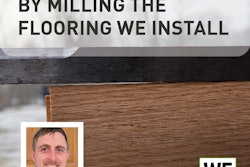The Problem
Last January, I was commissioned by a flooring manufacturer to inspect a prefinished 3-inch engineered oak floor that had developed dark spots. The homeowner was convinced the flooring was defective and wanted the floor replaced.
The Procedure
The Gulf Coast-area home was late-1970s construction with a concrete slab. The homeowner had moved into the house in 2002; the home had been vacant for a year before the sale was completed. Prior to move-in, she hired a contractor to replace all the floor coverings with engineered wood flooring adhered directly to the slab.
The homeowner observed several small dark spots begin to appear in the floor 10 months prior to my inspection (about six years after move-in). These dark areas increased in size and now covered a large portion of each room in the home. She said she used the cleaning product recommended by the wood flooring manufacturer and never mopped the floor with water.
The Cause
By the time of inspection, the dark areas in the floor encompassed about 40 percent of the floor. Moisture content readings revealed the flooring was saturated with moisture. However, the flooring was not delaminating, and no cupping was evident. No visible water entry was observed, and the homeowner stated there had been no broken pipes. Interior relative humidity was above 75 percent and the temperature was 74 degrees Fahrenheit.
An investigation of the exterior of the home revealed the soil line was above the first brick row around the home's perimeter. A black plastic soaker hose was placed adjacent to the slab under the soil. Drainage of the flower beds was toward the concrete slab, with only a minimum amount of open areas for water to flow away from the slab. The homeowner said the previous owner suggested using the soaker hose to water the slab for an hour once a week to help prevent the slab from cracking in the summer.
Because the home had been vacant for a year before the new owner moved in, the slab may have been at an acceptable moisure level when the new flooring was installed (the installer for this job was long gone by the time of the inspection, so no information about moisture testing at the time of installation was available). After completion of the installation, the homeowner introduced moisture to the slab as suggested by the previous owner, but the new wood floor did not allow the moisture to evacuate through the surface as did the old carpeting.
How to Fix the Floor
The flooring had to be replaced at the homeowner's expense and the slab watering technique discontinued. Because the soil was above the level of the slab, the new flooring had to be treated as a below-grade installation. Unfortunately for the homeowner, she did not have recourse with the installer or the manufacturer of the wood floor under the terms of the warranty.
In the Future
Water and wood flooring do not mix. Even if a home is more than 30 years old, that doesn't mean the slab is dry. Seasonal changes affect the moisture content of a slab, and so does the grading around the house. Flooring installers should always perform a moisture test on a slab prior to installation, check the grading around the home's foundation and educate the homeowner about what moisture can do to a wood floor. Adding water to prevent slab cracking is often recommended but seldom needed in the Gulf Coast area. This was an expensive lesson learned by the homeowner.






























